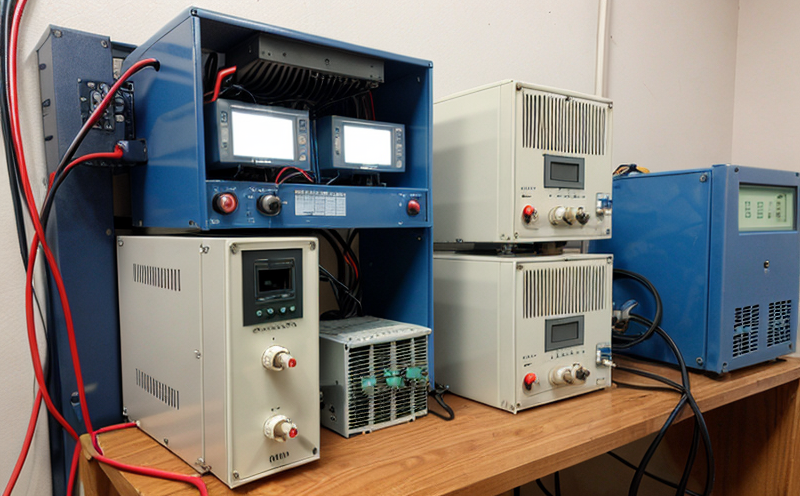IEC 60034 Traction Motor Performance Testing
The IEC 60034 series of standards defines the performance requirements for traction motors used in railway and transportation applications. This specific testing focuses on ensuring that traction motors meet stringent international safety, efficiency, and durability criteria. Traction motors play a critical role in electric trains and other high-speed transportation systems, providing power to move vehicles efficiently while maintaining operational reliability.
The testing process involves multiple stages aimed at evaluating different aspects of the motor's performance under various operating conditions. The tests are designed to simulate real-world scenarios that traction motors encounter during operation. This includes assessing the motor's ability to withstand high temperatures, vibration, and varying loads over extended periods.
One of the key parameters tested is the motor’s efficiency across different speed ranges. The IEC standards emphasize not only peak performance but also continuous operation under challenging conditions. Compliance with these standards ensures that motors can operate safely and efficiently in harsh environments typical of railway systems.
The testing procedure begins with a thorough inspection of the motor's components to ensure they meet the required specifications as per the standard. Following this, the motor undergoes several types of tests including insulation resistance measurement, no-load test, and load performance test. Each phase provides critical insights into the motor’s overall health and readiness for deployment.
Insulation resistance testing checks the integrity of windings against ground and between phases to prevent electrical faults. The no-load test measures losses at nominal voltage without any mechanical load, providing an initial baseline for comparison during subsequent tests. Finally, the load performance test evaluates how well the motor functions under actual working conditions by applying specified loads while monitoring key metrics like torque, speed, efficiency, and temperature rise.
| Standard Reference | Description |
|---|---|
| IEC 60034-19 | Traction motors for railway applications - Part 19: Performance characteristics and test methods |
| IEC 60204-1 | Safety of machinery - Electrical equipment of machines - Part 1: General requirements |
The results from these tests are meticulously recorded and analyzed to ensure that the traction motor meets all specified criteria outlined in IEC standards. This comprehensive approach guarantees that only motors capable of performing reliably under demanding conditions are approved for use.
By adhering strictly to IEC 60034 guidelines, manufacturers can demonstrate their commitment to delivering safe, efficient, and dependable traction motors suitable for railway and transportation applications worldwide. Such compliance also enhances confidence among stakeholders regarding the quality of products being supplied into global markets.
Why It Matters
The reliability and performance of traction motors are paramount in ensuring safe, efficient, and sustainable railway operations. Non-compliance with IEC standards can lead to potential safety hazards such as short circuits or overheating incidents which could disrupt services and compromise passenger safety.
From an economic perspective, failing to meet these stringent requirements might result in costly downtime due to premature failures of motors. Additionally, it may impact the reputation of both manufacturers and operators if there are instances where non-compliant products are used in critical infrastructure like trains.
- Safety: Ensures that traction motors operate safely within their designed limits reducing risks associated with electrical faults or mechanical failures.
- Efficiency: Guarantees optimal performance of the motor under various operating conditions thereby enhancing fuel economy and reducing operational costs for transportation operators.
- Durability: Helps in identifying weak points early on so that necessary improvements can be made before full-scale deployment, extending the lifespan of the product.
In conclusion, ensuring compliance with IEC 60034 standards is not just a regulatory requirement but also an essential step towards maintaining high standards of quality and performance in railway traction motor technology. It fosters trust among all parties involved—from suppliers to end users—and contributes significantly to the advancement of sustainable transportation solutions.
Applied Standards
| Standard Reference | Description |
|---|---|
| IEC 60034-19:2017 | Traction motors for railway applications - Part 19: Performance characteristics and test methods |
| IEC 60204-1:2018 | Safety of machinery - Electrical equipment of machines - Part 1: General requirements |
The IEC standards serve as the cornerstone for testing traction motors, providing a robust framework that encompasses all necessary aspects from initial design through final inspection. These guidelines ensure consistency and accuracy in evaluating motor performance across different environments and applications.
Quality and Reliability Assurance
- Thorough Inspection: Rigorous examination of the motor's components to verify conformity with IEC specifications.
- No-Load Testing: Measures losses at nominal voltage without mechanical loads as an initial performance benchmark.
- Load Performance Assessment: Applies specified loads while monitoring torque, speed, efficiency, and temperature rise under actual working conditions.
The combination of these rigorous tests ensures that traction motors are not only capable but also reliable enough for use in demanding railway environments. Regular audits and inspections further reinforce this commitment to quality by identifying any potential issues early on.





